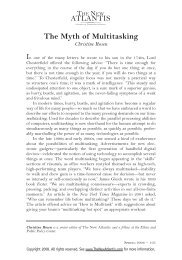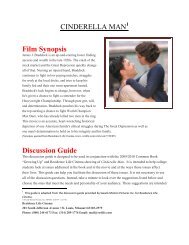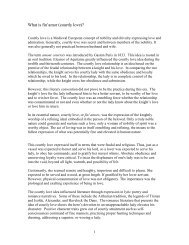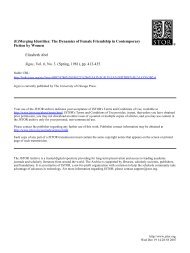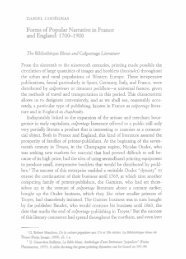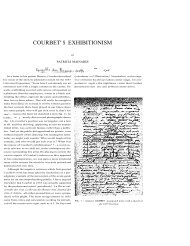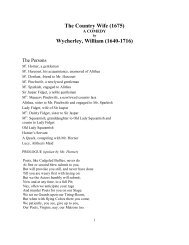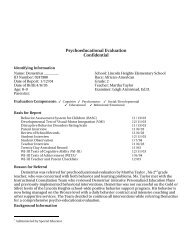CARRIE MAE WEEMS - People Search Directory
CARRIE MAE WEEMS - People Search Directory
CARRIE MAE WEEMS - People Search Directory
Create successful ePaper yourself
Turn your PDF publications into a flip-book with our unique Google optimized e-Paper software.
pletion of the Ain 't jokin series in 1988,<br />
folklore became integral to Weems's<br />
involvement with photography.<br />
Describing her time at Berkeley as a period<br />
of wondrous fascination, the artist<br />
notes that folklore provided a way for her<br />
to bridge her upbringing with Marxist philosophy<br />
and social action in a way she<br />
had not been able to do since the 1970s.'0<br />
Folklore's analysis of diverse social groups<br />
and their belief systems, as well as its<br />
emphasis on "bearers of lore," audiences<br />
and observers, also intersected positively<br />
with Weems's earlier training in semiology<br />
and deconstructive theories. As she<br />
describes it, her deepening involvement<br />
in African American folk material gave her<br />
a foundation from which to work effectively.<br />
The challenge became one of locating<br />
the conjunctions between her photographiC<br />
image-making and the larger<br />
African American folk tradition, recasting<br />
both in her own voice.<br />
Having gained a new knowledge base,<br />
Weems began collecting both African<br />
American and Anglo-American loreeverything<br />
from songs, stories and folk<br />
sayings to racist jokes and memorabilia.<br />
The early results of this research led her<br />
to the Ain'tjokin series of 1987-88. A<br />
major part of Weems's enterprise in Ain't<br />
jokin involves breaking down black and<br />
white "fictions of coherence," those myths<br />
of race, class and gender that become<br />
"truth" through repetition. Using the<br />
resources of folklore and photography,<br />
she powerfully attacks racist stereotypes<br />
as perpetuated in Anglo-American folk<br />
culture and exposes the joke's power to<br />
limit opportunity. In the same way that<br />
Jenny Holzer addresses the charade of<br />
social mores, Hans Haacke deals with the<br />
structures of corporate power or Barbara<br />
Kruger critiques identity construction via<br />
advertising, Weems sets out to make us<br />
understand that racial prejudice occupies<br />
some of the deepest structures within the<br />
American psyche.<br />
The mental and material domination<br />
of Africans and African Americans via<br />
stereotypes is as old as four centuries of<br />
associating blacks with apes or two centuries<br />
of sassy southern mammies and<br />
grinning sambos (plates 14-16)." Berkeley<br />
folklorist Alan Dundes in Interpreting<br />
Folklore, as well as social psychologists<br />
Sander Gilman in Difference and<br />
Pathology and Arthur G. Miller in<br />
Contemporary Issues in Stereotyping, all<br />
have discussed the nature, histolY and<br />
effect of social stereotypes." Although<br />
they agree that stereotypes are not negative<br />
by nature, stereotypes are seen as<br />
exaggerating differences between groups<br />
for "contrast effect." This kind of contrast<br />
and limit-setting turns ugly when the<br />
ethno- and egocentrism of one group,<br />
especially the dominant culture, combines<br />
with the psychodynamic factors of projection<br />
and scapegoating to oppress another."<br />
As Dundes has phrased it, "projection<br />
provides protection," and the group<br />
which is perceived as threat or taboo is<br />
imprisoned within the folkloric fantasy of<br />
the stereotype.'" Once the stereotype of<br />
the "other" is fixed, it becomes the object<br />
of jokes, carrying the dominant culture's<br />
anxieties on its back. Again according to<br />
Dundes, because jokes as stereotypes are<br />
a socially sanctioned way to talk about<br />
anything that's not socially sanctioned,<br />
they become more prevalent and virulent<br />
after important events and during times of<br />
historic change."<br />
Weems's Ain'tjokin series confronts<br />
racist humor as a process of projection<br />
and scapegoating-a mirror held up to<br />
reveal Anglo-American oppreSSion. Using<br />
her own lifetime as a starting pOint, she<br />
concentrated on jokes from the Civil<br />
Rights era. In the 1950s and 1960s, when<br />
blatantly expressed racism became less<br />
acceptable, the ethnic jokes that<br />
reemerged became an important indicator<br />
of real social integration, or the lack<br />
thereof.26 By juxtaposing these texts with<br />
photographs, Weems dramatically ~ransforms<br />
the jokes into a positive attack on<br />
negative humor. She uses them to question<br />
our integrity in continuing to create<br />
and be amused by such racist stereotypes.<br />
The moral premise of the series is<br />
found in its title. "Ain't jokin" is a double<br />
entendre which not only points to jokes<br />
as expressions of people's true feelings<br />
but also asks the question, "Can you<br />
believe this' No really. I really heard<br />
someone say it. I'm not joking." Like<br />
Adrian Piper's business card "1 am black,"<br />
which she hands out at social occasions<br />
23




